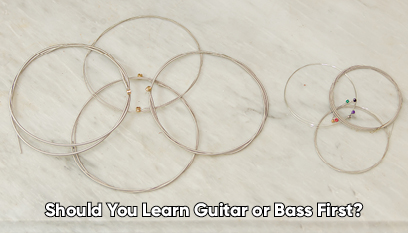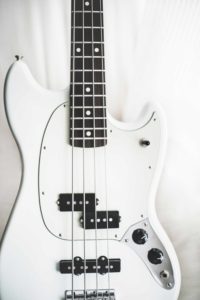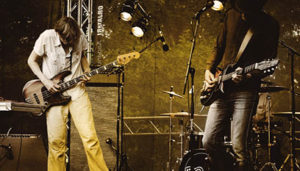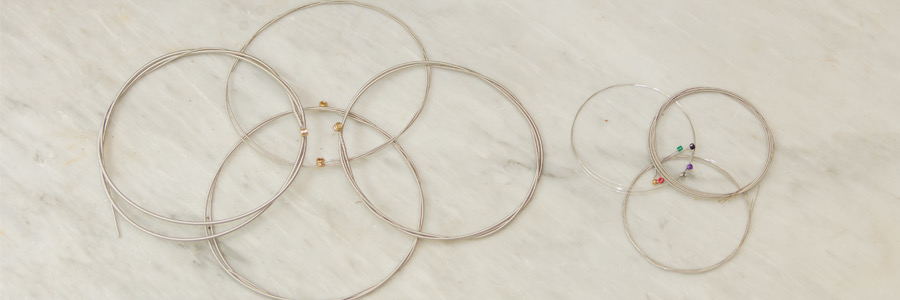
Many people end up playing both guitar and bass, and there is certainly significant overlap between them. But which one should you play first, if you’re just starting out? My suggestion is that you consider why you are looking to take up an instrument in the first place.
You may want to learn guitar if:
- You want to write songs
- You want to be able to play recognizable songs without accompaniment
- You love the idea of being the frontman of a band
- You prefer the sound and feel of the guitar
You may want to learn bass if:
- You want to make people dance because of the music you create
- You want to play in bands, but you have no interest in the spotlight
- You prefer the sound and feel of the bass
- You want to be able to do a lot of fill-in work
Here are a few points about each instrument to help you make up your mind.
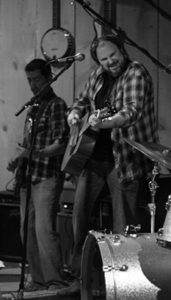
Physical Differences Between Guitars and Basses
Both acoustic and electric guitars are usually six-stringed instruments tuned (low to high) to E-A-D-G-B-E. Seven- and twelve-string guitars are also available, but is very rare for someone to start with these variations.
Compared to a guitar, the average bass is an octave lower, and has fewer strings, thicker strings, and wider frets. Most basses have four strings, which are tuned the same E-A-D-G notes a guitarist would be familiar with.
The most common variants of bass guitar are the five-string and six-string. A five-string bass has an additional low string (usually tuned to B), and a six-string bass adds both a high string and a low string (both usually tuned to B). Just like with the seven- and twelve-string guitars, it is rare for someone to start learning the bass on anything other than a traditional four-string bass.
If you’re really unsure which instrument you want to play, go to a music store and physically handle a few of each. You might find that basses feel too heavy and unwieldy to you, or that guitars feel puny. For example, say you’re 6’5” and your hands are huge. A bass might feel more comfortable to play because the strings are fatter and the frets are further apart. If you feel yourself drawn in a particular direction, go with it.
Short-Scale Basses
Don’t let the bass scare you off just because you’re of smaller stature, though. (I’m nowhere near 6’5” myself, so I know what I’m talking about here!) You have options. Most basses are what is called long-scale. This refers to distance between the bridge and the nut, which is usually 34 inches. A smaller person may be more comfortable playing a short-scale bass, which has a shorter distance between bridge and nut (30 inches), a narrower fretboard, and less distance between frets.
There is also the Fender Bass VI (also known as the Fender VI), which is a six-string. Like other basses, it is an octave lower than a traditional guitar, but unlike other basses, it is strung with thinner strings and tuned E-A-D-G-B-E like a guitar. If you’ve seen the “Hey Jude” promo film, you’ve seen George Harrison playing one. While Fender discontinued production in 1975 due to low demand, the 2013 reissue under the Fender Squire imprint has made this rare beast attainable to the masses who have lusted after them for years.
Fretless Basses — Something to Grow Into
For players looking to start an instrument that will eventually hand them a new challenge, picking up the bass offers a unique opportunity when compared to guitars: the fretless bass. Playing a fretless bass gives you the ability to add more expression to your playing. Common techniques are sliding into and out of notes and also heavy doses of vibrato.
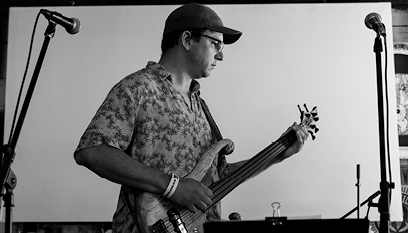
A fretless bass
It is true that fretless guitars exist. However, they are basically only seen in the world of the true virtuoso players like Steve Vai. There also isn’t much of a community of support for this instrument. A quick Google search will show you that one of the top video results is simply titled, “Why Did I Buy This?? — Getting a Fretless Guitar.”
On the bass side, you’ll find an enthusiastic community of fretless players and even beginner fretless models at reasonable prices. However, I wouldn’t recommend that a beginner jump right into fretless playing unless they have previous experience with non-fretted stringed instruments like cellos or violins.
Those are the main physical differences between the guitar and the bass. There are a lot of other differences, though, when you actually go to play these two instruments.
Differences in Playing Styles (Lead, Rhythm, and More)
In a band, the bass player is responsible for holding down the low end. They work with the drummer to set the groove. When you just can’t stop yourself from dancing at a concert because you can feel the beat in your chest, you are dancing to the bassline and the kick drum. Bass players love being part of that. For them, playing feels powerful in a way that playing guitar just can’t match.
The guitarist, on the other hand, generally has more versatility in a band. Guitarists can play rhythm parts, riffs, or solos. Because the drummer and bassist are keeping the beat and laying down the groove, guitarists often have more freedom to do their own thing.
Guitar playing is generally broken down into two kinds of playing styles: lead and rhythm. John Lennon and George Harrison of the Beatles are classic examples. As the rhythm player, Lennon primarily strummed, which gave the songs their familiar chord changes. As the lead player, Harrison played solos and melodic riffs played over the chords.
Some guitarists don’t fall neatly into either the lead or rhythm camp. This is often seen in power trios or bands with only one guitar player, such The Who (Pete Townshend) and the James Gang (Joe Walsh). These players develop styles that hold down the rhythm while simultaneously soloing. These kinds of bands also allow the bass player a chance to stretch out a bit and take up more space. Geddy Lee of Rush and John Entwistle of The Who are two great examples of such bass players.
Then there’s slide. Slide guitar is a famous variant originating in blues and Hawaiian music. It was later popularized by British blues players like Brian Jones of the Rolling Stones and Duane Allman of the Allman Brothers Band. In blues and rock music, slide playing is mainly used as a form of lead playing. However, folks like David Tronzo are bringing slide playing into jazz and experimental music, using effects and alternative slide materials to make new soundscapes.
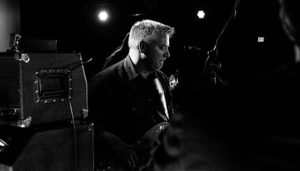 Thoughts from an Expert
Thoughts from an Expert
To get some background for this post, I chatted with my friend Kim Bird. Kim has a Master’s degree in music and a degree in double bass performance. She is a full-time professional musician and bass instructor, and plays in various ensembles near her home in Denver. Needless to say, she is a really badass bass player, and a great guitar player as well. Here are some of her thoughts:
“There are pros and cons to learning either first. Bass can be easier because you don’t have to deal with chord shapes, but it can be harder to push down the strings. It can also be tough to stay motivated because you can’t really play by yourself. I really do think bass attracts team players — those looking to stay out of the spotlight. I learned guitar first, but eventually switched to bass because I liked the lower sound and register. Guitarists can be great bassists if they think like a bass player and understand how their note choices and rhythm affect the whole group. That’s what they mean by “playing in the pocket” — those are bass players who keep the groove going without flash. It’s not that they can’t play more involved parts, it’s that they realize they don’t have to!” -Kim Bird, Professional Bassist
For more thoughts from Kim, along with some other great female guitar players, check out Guitars for Women, with Review of the St. Vincent Guitar.
Guitar is More Popular
It’s no secret that far more people play guitar than bass. One reason is that it’s more fun to play guitar on your own. The chord changes and lead melody are usually the most recognizable part of a song, so playing the bassline all by itself just not as satisfying. It takes a very advanced bass player to perform on their own in a form that an audience is interested in listening to. So if you’re looking to start playing solo shows anytime soon, go with the guitar.
The relative scarcity of bass players has contributed to the trope that bass players are just lousy guitar players who wanted a spot in a band. It’s true that a decent guitarist should be able to play mediocre bass without much trouble. With a bass, there are no chords to memorize — and it’s easy for a bass player to just play the root notes off the guitar parts. That can make the bass seem deceptively easy. But it’s very difficult to become an exceptional bass player, and the world needs more of those.
Another reason that the bass is less popular is that the majority of the attention in bands is paid to the singer and/or the lead guitarist. These musicians are often front and center stage, while most bass players are back with the drummer and often off to the side. There are of course exceptions to this rule (McCartney / Sting / Lemmy). But overall, if your rockstar fantasy involves thousands of adoring fans screaming your name, playing guitar will likely hold more appeal
If You Think Bass is Boring
In a lot of popular music, bass players are not given anything exciting to do — they just play root notes and maintain the groove. But rock, funk, and jazz have given rise to some of the most creative and influential bass players of all time.
If you still think bass is boring, check out some videos of these masters at work:
John Entwistle (The Who)
Bootsy Collins (James Brown / Parliament-Funkadelic)
Cliff Burton (Metallica)
Victor Wooten (Bela Fleck and the Flecktones)
For further listening/watching please consider:
- John Paul Jones (Led Zeppelin)
- Jack Bruce (Cream)
- Geddy Lee (Rush)
- Paul McCartney (The Beatles)
- Pino Palladino (The Who / John Mayer)
- Carol Kaye (The Wrecking Crew)
- Charles Mingus (Various)
- Tony Levin (King Crimson)
- Les Claypool (Primus)
- Flea (Red Hot Chili Peppers)
- Lemmy (Motorhead)
- Aston Barrett (Bob Marley and the Wailers)
After watching some of these masters do their thing, you’re probably wondering how bass got a reputation for being boring and easy. Largely it has to do with popular bands whose signature bass sound is extremely simple (U2’s Adam Clayton, I’m looking at you), or bass players who were brought into the bands for their image rather than their skill, such as the Beatles’ first bass player, Stuart Sutcliffe, and the Sex Pistols’ most famous bass player, Sid Vicious.
Most bass players are not Entwistles or Sutcliffes. The vast majority of the bass work out there falls in between these skill sets, and can be broken down to the bare bones in a pinch. As long as the player stays in key and provides the expected groove, the audience would rarely know if a few notes here or there are missing.
A lot of bass playing is based on genre-specific patterns. Once you know these patterns, filling in for a bass player on vacation or backing a singer-songwriter who’s looking for some support on a special gig can be pretty easy.
Is There a Cost Difference?
Budget is always something to bear in mind when taking on a new endeavor. You may not be sure if the hobby will take, so it’s a good idea to consider what the startup costs may be, as well as the long-term investment if you stick with it.
Starter packs for bass tend to be about $50 more expensive than guitar packs. Remember the bass is a larger instrument with larger tuning machines, pickups, and strings. Guitar players come out ahead here.
Speaking of strings, you may get sticker shock when you start shopping. Bass strings cost around $20, while guitar strings start closer to $5. The good news is that bass strings tend to last a very long time, so bass players actually win.
As the hobby develops, guitarists tend to add more pedals at a quicker rate as they learn new material. Bass players come out ahead here as they tend to use fewer pedals, if any. (Wondering if you can use guitar pedals for both instruments? Check out this post about using guitar pedals with a bass.)
The cost of upgrades to amps and the instruments themselves from the starter packs to higher quality replacements tend to be about even between guitar and bass. That being said, guitarists tend to purchase more guitars over their playing career than bass players do. Think about the last show you were at. How many times did the guitarist switch out their guitar? Did the bass player swap out? Probably not. Advantage: bass.
Can You Learn Both at the Same Time?
Sure. This is your musical adventure, after all. You do you. It’s likely that you’ll have a hard time mastering two new instruments at once, though. You’ll also have to purchase two sets of instruments, amps, and pedals if you want the traditional guitar and bass tones, find a guitar teacher who can teach you bass too (or two teachers), and — oh yeah — find time to learn and practice two instruments. Any form of cross-training in music is helpful, but focusing on one instrument while dabbling in others is probably the most realistic approach.

